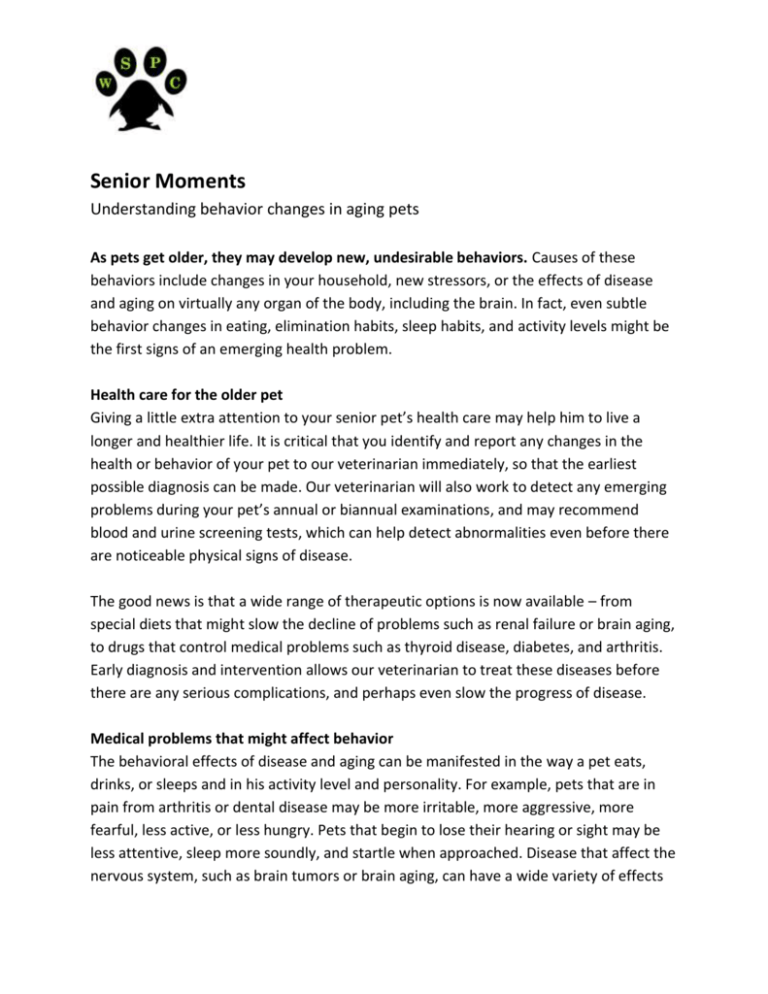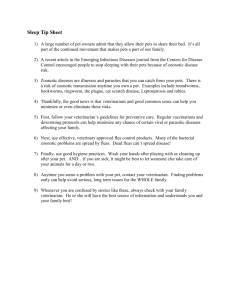Senior Moments - West Side Pet Clinic
advertisement

Senior Moments Understanding behavior changes in aging pets As pets get older, they may develop new, undesirable behaviors. Causes of these behaviors include changes in your household, new stressors, or the effects of disease and aging on virtually any organ of the body, including the brain. In fact, even subtle behavior changes in eating, elimination habits, sleep habits, and activity levels might be the first signs of an emerging health problem. Health care for the older pet Giving a little extra attention to your senior pet’s health care may help him to live a longer and healthier life. It is critical that you identify and report any changes in the health or behavior of your pet to our veterinarian immediately, so that the earliest possible diagnosis can be made. Our veterinarian will also work to detect any emerging problems during your pet’s annual or biannual examinations, and may recommend blood and urine screening tests, which can help detect abnormalities even before there are noticeable physical signs of disease. The good news is that a wide range of therapeutic options is now available – from special diets that might slow the decline of problems such as renal failure or brain aging, to drugs that control medical problems such as thyroid disease, diabetes, and arthritis. Early diagnosis and intervention allows our veterinarian to treat these diseases before there are any serious complications, and perhaps even slow the progress of disease. Medical problems that might affect behavior The behavioral effects of disease and aging can be manifested in the way a pet eats, drinks, or sleeps and in his activity level and personality. For example, pets that are in pain from arthritis or dental disease may be more irritable, more aggressive, more fearful, less active, or less hungry. Pets that begin to lose their hearing or sight may be less attentive, sleep more soundly, and startle when approached. Disease that affect the nervous system, such as brain tumors or brain aging, can have a wide variety of effects on behavior, including personality changes and disorientation. Endocrine imbalances, disease, and deterioration of virtually any organ (e.g., heart, liver, kidneys, lungs, brain) can have a wide variety of effects on your pet’s behavior. Brain aging As the body ages, so does the brain. Changes in the brains of older dogs and cats are similar to changes in elderly people. Recent studies of dogs indicate that, as in humans, the effects of aging on the brain range from no effect at all to severe dementia. Older pets may become less aware of their environments, develop signs of memory loss, and exhibit a decline in learning ability. This can occur as early as eight to nine years of age in some dogs, while others retain healthy brain function throughout their lives. In cats, signs associated with brain aging generally emerge at a slightly older age. There is a wide range of signs associated with brain aging, including: Disorientation – your pet might be disoriented if he gets lost in familiar places, gets stuck behind furniture, or shows decreased responsiveness to sights and sounds. Activity changes – pets may begin to sleep more and play less. As cognitive function declines, there may be an increase in activities such as restless pacing, licking, or repetitive barking. Sleep cycle alterations – your pet may experience restless, unsettled sleep or waking at nights. Changes in social interactions – your pet may become less interested in greeting or social play with familiar people or pets. Some pets may become more irritable. Apathy and depression – your pet may have less interest in people, other animals, toys, eating, and grooming. Anxiety – signs of anxiety include fear of sounds, people, or environments; a desire not to be left alone as much; and an increase in irritable aggression. Learning and memory – the ability to adapt to new environments and learn new tasks may be greatly impaired. Dogs may no longer respond to some of their previously learned commands, be less able to perform tasks learned in agility or obedience training, or be less able to function in the work for which they were trained (e.g., drug-sniffing dogs, seeing eye dogs). House soiling may also be a sign of declining memory in both cats and dogs. Our veterinarian can determine the cause of these physical signs by completing a physical examination, a neurological examination, and diagnostic texts. Depending on the findings, more specialized testing, such as ultrasound or brain imaging, may also be needed. Treating behavior problems in the older pet Fortunately, treatment for these problems is now available in the form of a prescription diet or a special drug that may improve physical signs and perhaps even slow the progress of cognitive dysfunction disease in dogs. Currently, there is no treatment for signs of brain aging in cats, but research continues in this area. In addition to medical therapy, you may need to make some alterations in your pet’s environment. For example, if your dog has renal failure or diabetes, he may need to make more frequent trips outdoors or need a doggie door. Cats might need to have their litter boxes cleaned more frequently, need a larger littler box, or require a litter box that is more easily accessible if they begin to have failing sight, develop arthritis, or become weak. Recent data suggests that keeping pets physically and mentally active may also improve cognitive function. Exercise your pet daily, play games with him frequently, review simple obedience commands during his daily walks and play, and occasionally provide new toys. And, of course, be sure to give your pet lots of love and attention during his golden years.





